The New PowerStop Prop: A Prop That Works in Reverse!
Have you ever wondered why sterndrive and outboard props never seem to work very well in reverse? The reason is that the props are designed to provide maximum performance when going forward. The result is that some types of boats, such as houseboats, pontoon boats and barges are seriously challenged when slowing down, stopping, or maneuvering. Making a prop that was good at going in reverse has historically severely denigrated forward performance. Until now.
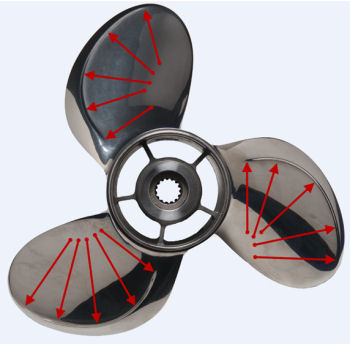 Looking aft on this left-hand turning prop the red arrows point to the ridge on the surface of the prop blade that makes all of the difference. |
Report on the PowerStop! Prop--
It all started about nine years ago when the techs from PowerTech! were exhibiting at the Louisville, KY houseboat show. Many of the houseboat owners complained that stopping their boats was very difficult. Because of the huge windage of house boats, to say nothing of their weight, accidents were common and they usually involved hitting the dock while going too fast.
Even more interested in a solution were operators of rental houseboats and pontoon boats who were tired of high repair bills to their fleet. And their insurance rates were sky high as a result. A good solution would save them big money in insurance and the repair bills for the deductible.
That is when the folks at PowerTech! began thinking about a solution to this problem and addressing the houseboat, pontoon boat, and recreational barge market. This later type of boat is not too common in the US, but canal and river boats are all over Europe and are virtually all rentals.
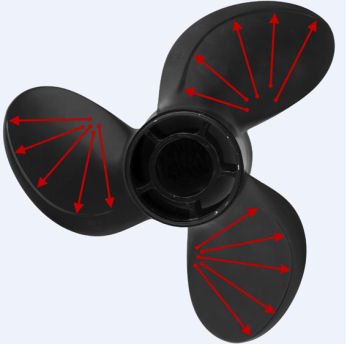 On this aluminum prop the red arrows point to the "reverse cup." This is the primary design innovation that gives the prop its stopping power. |
Who is PowerTech!?
As regular readers of BoatTEST.com know, PowerTech! is our "go-to" source for all questions we have about props. It is a 30-year-old company located in Shreveport, LA that specializes in the design, manufacturer and sale of both stainless steel and aluminum recreational marine propellers. The company is known for its quality, innovation, huge inventory of prop designs (over 5,000), and its remarkable, one-on-one customer service. (The latter is primarily on the phone and by email to customers all over the world.)
PowerTech!'s technical advisers actually answer the phone and call people back to help solve their prop and boat performance problems related to props. Today, these service associates talk to more end-users than does any other prop manufacturer on the planet. As a result, PowerTech! knows what is going on in the field and what customers with all different kinds and sizes of boats want all over the world.
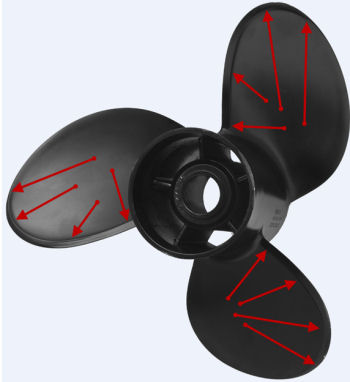 The red arrows are pointing to the cup on the trailing edge of the new PowerStop! prop. This is what gives the prop its power in forward. |
An Old Problem
Propeller design goes back to the early 19th century and the problem of poor performance in reverse was evident right from the beginning of steam driven vessels. This is one of the reasons why paddle-wheel propelled river boats were so popular. With both current and wind pushing these large boats where the skipper did not want to go, he had to have a reliable -- and powerful -- reverse. Paddles were the first, best answer.
Over the years many designs for reversing props were patented but all had one major failing -- they were terrible when going forward. During the mid-19th century propeller design improved to the point that offshore vessels (usually side-wheelers) no longer needed the paddle system. There were inherent advantages in having the prop below the boat, but the problems of reverse were really never solved other than by approaching docks very slowly.
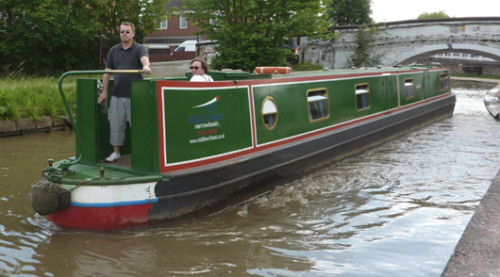 Recreational rental barges in the UK are long, narrow, and hard to stop in reverse. These type of boats were an ideal way to test the new PowerStop! prop. |
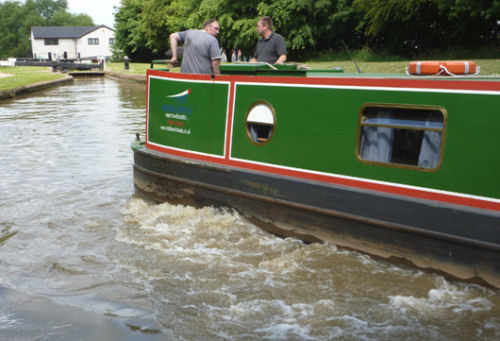 In full reverse the PowerStop! was said to be able to stop in 57% less distance than was a recreational barge with a conventional prop. |
The Rental Market First
Once PowerTech! let it be known they were working on a viable solution for a solid reverse, operators of rental pontoon boats and houseboats in the US and river barges in the UK began showing interest. This was the first indication that there might be a market large enough to warrant the costly investment in tooling that propellers require.
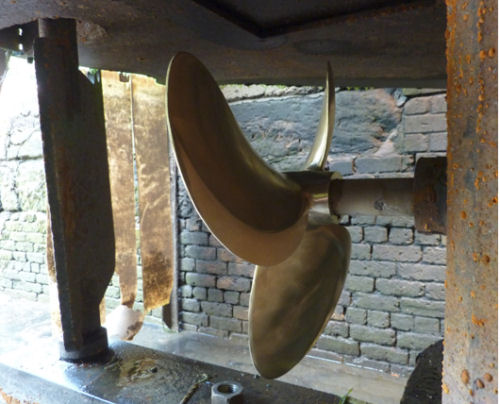 View of the PowerStop! prop fitted on the UK barge. Like outboard and sterndrive props, this one also has a horizontal plane of attack. |
A couple of years ago a large deckboat/houseboat operator in the American heartland told PowerTech! that if he could be satisfied with a suitable design, he would order a large number of the props. In the course of perfecting the design, this operator became the chief testing officer of the new product. If it couldn't pass muster with him it would be destined to die like many other prop designs have over the last 150 years.
The Prototype Design
The first prototype prop was made in aluminum, a material that would be easy to work as the inevitable modifications would be made to discover optimum shapes. The design had to have a cup for "grip" on the leading edge for forward performance. But when backing this cup knocks water away from the blade's surface, which is one of the things that cause poor reverse performance. This dynamic would have to be overcome.
PowerTech!'s solution was to fair cupping into the underside of the leading edge and create an aft tapered cup in the top of the trailing edge. These two cups on opposite sides of the blade would grip the water and give better control whether going forward or backward.
On the side of the blade facing the boat, PropTech! created a ridge that is from 8% to 12% of the way back from the blade's edge. The ridge is as high as 3/16" above the surface of the blade. This design in effect creates a "double-cup" and it is the single most important element in making the reverse so powerful.
The leading edge of each blade is also a bit thicker than on conventional props, which should, also, enhance the PowerStop!’s durability.
Several prototypes were made and sent to the rental pontoon boat operator for trial. Testing was also done by PowerTech!'s UK distributor in the canals outside of London. This time the prop was Nibral and the application was an inboard canal boat. It followed the same design as used on the outboard engines in the US.
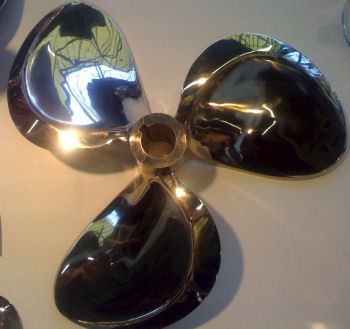 This is the Nibral test prop used in the Thames (UK) from the METS show in Amsterdam. |
Results of the Testing
In the UK, a typical long, narrow canal boat was tested both with PowerStop! and with a conventional prop. It is reported that the stopping distance for the barge with a conventional prop was 35' at a given speed. With the PowerTech! prop the vessel was able to stop in just 15' when traveling at the same rate. This is a 57% reduction in stopping distance, something that automobile manufacturers would die for.
Back in the US, the deckboat tester reported remarkable, even surprising, results with the PowerStop!. On his first run, the tester was surprised by just how effective the PowerStop! really was, joking that “it just might be too good,” since, as with most veteran operators, he had expected that engaging reverse would be ineffectual, at best. As testing continued, the tester noted that, "If I stay in the throttle, the boat wants to plane in reverse.”
A PowerTech! spokesman told us that reverse performance enhancement with the new prop had been found to be as good as a 300% improvement in stopping performance in some tests.
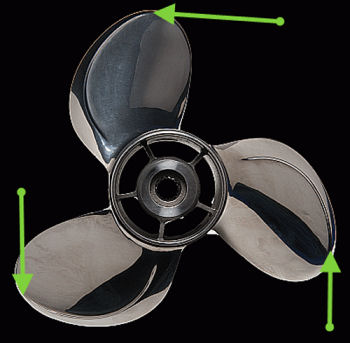 By pulling the ridge back from the leading edge, the prop-makers were able to achieve the stopping power needed without seriously harming the forward performance. |
Forward Performance
We are told that in the testing phase with the prototypes that only a slight loss of forward speed was indicated, with no loss on the houseboat and minimal losses of 1 mph, or less, on, both, the UK canal boat and the deckboat. Granted, these vessels are relatively slow applications, and it remains to be seen what loss of forward performance might occur on high-speed sportboats.
But, for now, we are told by the folks at PowerTech! that the PowerStop! prop design is limited to houseboats, pontoon boats, canal boats, barges, work boats, yard boats and crew boats. But it is clear in talking to the staff at PowerTech! that the company has its eye on other possibilities, as well.
PowerStop! is On the Market
The PowerStop! prop was put on the market last year targeted at V-6 E-Class engines with pitches of 11",12" and 13" and a 15.5" diameter in aluminum (retail price: $228.70). Appropriate applications are for pontoon boats powered by 150 to 250-hp outboards. A stainless steel model is available in a 12 x 15.5 size (retail: $587.26). Aluminum models have a square hub that’s designed to work with the Mercury Flo Torque hub insert, which is available to match almost any outboard brand. The stainless PowerStop! unit comes with a CushionLok hub which is a PowerTech! patented product.
We are told that 15" to 17" props that might be suitable for runabouts are in the works. Other PowerStop! prop models are in the works with an even larger diameter for use with the MerCruiser Bravo II sterndrive.
If you want more information about the PowerStop! prop go to the PowerTech! website at ptprop.com.